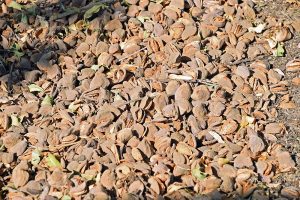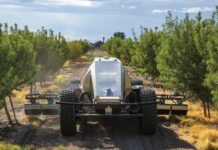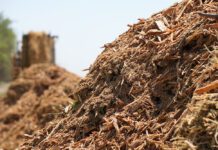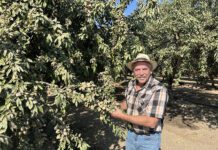
Crop inputs, always important in almond production, are even more so in a big crop year. And with budgets tight after low prices and average yields the last two years, Franz Niederholzer, UCCE farm advisor for Colusa, Sutter and Yuba counties, said the upcoming year could present significant challenges for almond growers.
“This upcoming year will be perhaps the most challenging year in a while if this large crop scenario comes through,” Niederholzer said. “Growers are generally working with a smaller budget, but they could be facing higher demands for certain inputs.”
After two straight years of light crops, many are projecting the 2024 almond crop to be a big crop to the tune of 3 billion pounds. With that in mind, Niederholzer offered some advice to help growers get the most out of their 2024 almond crop.
Nitrogen
Perhaps the most important input almond growers need to think about in 2024 is nitrogen, Niederholzer said. “Successfully producing a big crop requires a lot of nitrogen. The bigger the crop, the more your nitrogen demand is going to be.”
An almond tree has sizable nitrogen needs throughout most of the spring, Niederholzer said, and UC Davis recommends spoon feeding it through irrigation systems on a weekly basis. Applications should begin as early as March, depending on the weather, and start to slow by hull split in late June when a tree’s nitrogen demands tail off.
“UC Davis used to recommend a 20/30/30/20 program, where you put 20% of your nitrogen on early, say the middle of March at full leaf-out, followed by 30% at shell hardening and another 30% at nut fill and then another 20% later in the season,” Niederholzer said. “That program increased nitrogen use efficiency compared to previous programs, but now Dr. Patrick Brown’s lab at Davis recommends applying so many units a week and directly feeding it through your sprinkler system in the amount that corresponds to the crop use at that time.
“Knowing when the crop is going to use it and getting it delivered efficiently is critical to both nitrogen and potassium applications,” Niederholzer said.
Neglecting a tree’s nitrogen demand can result in smaller nuts and, depending on how deficient the nitrogen, could lower the next year’s yield as well. “For long-term productivity, you want to try to stay above those minimum leaf nitrogen and potassium levels,” Niederholzer said.
“We’re not looking for maximum nutrient management, but for optimum nutrient management,” he added. “If you have a big crop, take regular leaf sampling, certainly in the spring, to see if you’re falling behind and feed accordingly.”
One alternate source of nitrogen that growers can consider involves planting a legume cover crop. “That is an alternative source that may help a grower cut down on the nitrogen they bring in on the truck,” Niederholzer said. Groundwater nitrates are an additional source of nitrogen to be considered. Growers can use the Almond Board of California’s booklet Nitrogen Best Management Practices to fine tune their nitrogen program, he added.
Potassium
Like nitrogen deficiencies, potassium deficiencies should be avoided. “Maintaining good potassium levels, or at least adequate potassium levels, is essential to the long-term productivity of an orchard,” Niederholzer said.
In a light crop year, soil potassium can be enough to meet a crop’s needs, Niederholzer said, but in a big crop year, it can be deficient, especially if maintenance applications are not kept up. Almonds, in fact, use more potassium per unit of crop produced than nitrogen, Niederholzer said, typically using about 90 pounds of potash (K2O) per 1,000 pounds of kernel crop, versus about 68 pounds of nitrogen for the same amount of crop.
As for application timing, Niederholzer said there is no sweet spot for applying potassium. The crop uses potassium at a regular clip from March through July. The object is to keep adequate levels of the nutrient available to the crop throughout the growing season.
Growers with high-pH soils can use potassium thiosulfate to help lower pH, he added, and growers with low-pH soils can use potassium carbonate, an alkaline source, to bring up soil pH. “There is a price tag that comes with those amendments,” Niederholzer said, “but both of those products are effective and come in stable liquid form.”
Also, when applying potassium in dry form, Niederholzer said growers should make sure it is applied where water will be applied the next year. “You want to band it as close to the dripline as you can,” he said.
d in almond shells. “They are not a huge source (about 35 pounds K2O per ton), but if you could put on two to three tons of shells per acre, it’s good mulch for the winter, helps increase water infiltration and lessens erosion,” he said. “And the potassium in those shells will leach out with the rainfall and you’re putting potassium back in the orchard, and that’s a plus.”

Crop Diseases
When it comes to managing crop diseases, Niederholzer again said growers should be vigilant. “This last year, there were growers that skipped a fungicide spray with rain in the forecast hoping it wouldn’t rain, and it turned out it actually did rain and they had disease outbreaks,” he said. Leaf loss from rust, scab, Alternaria and anthracnose can reduce flowers and yield the following year as well as affect the current year’s crop.
Niederholzer said growers may be able to skip a second fungicide application if conditions are dry. “One good spray where there’s very little rain at bloom is going to be effective,” he said. If rain is in the picture, growers will want to consider two applications.
If going with a single application, doing so when 40% to 50% of the flowers are open is recommended. In a wet year, recommendations are to come in at pink bud stage and at full bloom.
Avoiding any bloom sprays is risky, Niederholzer said. “One good dew event and there could be infection,” he said. “So, budget for one spray as much as possible and talk with your PCA about making sure the one spray contains the materials to give you maximum pest control at that timing.”
Group 3 fungicides are effective on the main diseases of concern in almonds, including brown rot, he said, but not so much on jacket rot, which can be a problem in a year with a cool bloom period. Group 9 fungicides are generally effective on jacket rot, so should be considered as a tank mix partner in a cool bloom year, he said.
Insect Pests
As for insect control, Niederholzer said it is important to remove mummies from orchard floors to protect against navel orangeworm infestations. Occurrences this past year when many growers lost significant yield to the pest drive that home, he said.
“The critical first step is to do orchard sanitation,” he said. “Shaking the mummies out of the trees and sweeping them up and destroying them is always important. It is even more important in a year like this next year when the overwintering population coming out of this crop should be very high.”

As for insect sprays, Niederholzer said whenever possible growers should consider using materials that don’t harm natural enemies. “Research shows that spraying materials that are safe on beneficial mites and insects can really help manage your mites,” he said. A list of pesticides and their impact on beneficial insects in almond production is available at ipm.ucanr.edu.
A careful spray job that delivers the best coverage possible gives the best return on any money spent on product, diesel and labor, Niederholzer added.
In general, Niederholzer said managing for a big crop in tight times means prioritizing proven inputs and cutting back due to budget demands, but not ignoring proven practices. “Economic sustainability will come from working somewhere between ‘not missing any chance to spray’ and ‘walking away from critical inputs.’
“Growers know this from experience, but reviewing and careful planning should be helpful going into what could be another challenging year,” Niederholzer said.















